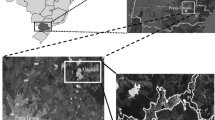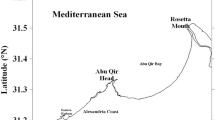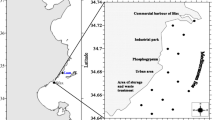Abstract
This article presents the results of studies of the content of heavy metals (zinc, copper, lead, cadmium, and nickel) in the muscles and liver of the main commercial fish of different levels of the trophic chain, e.g., pike, perch, roach, and bream, caught in the Astrakhan region, Chernoyarsk district in the water of the Volga River. The distribution of metals in the body of hydrobionts is uneven and depends on the properties of the metal itself and the functional characteristics of the organs. It was found that the content of these metals in the Volga water and the muscles of hydrobionts does not exceed the maximum permissible concentration. The goal of our work was to determine the content of heavy metals in the tissues (muscles) and organs (liver) of the most important commercial fish of the Volga basin within the Astrakhan region (Chernoyarsk region) and to assess the safety of their use as food raw materials. For the research, water samples were taken according to GOST 31861-2012. The content of heavy metals in water was determined via inversion voltammetry on a TA-2M analyzer and in the muscle tissue and liver via atomic absorption spectrometry on a Quant-2A instrument. The highest concentration of heavy metals, 0.14–39.6 mg/kg, is found in the internal organs (liver), and the lowest concentration, 0.038–8.13 mg/kg, is found per unit mass of muscle tissue.





Similar content being viewed by others
REFERENCES
Al-Bairuty, G., Shaw, B.J., Handy, R.D., and Henry, T.B., Histopathological effects of waterborne copper nanoparticles and copper sulphate on the organs of rainbow trout (Oncorhynchus mykiss), Aquat. Toxicol., 2013, vol. 126, pp. 104–115.
Codex Alimentarius. Food hygiene. Basic Texts, Rome: UN Food Agric. Org., 2003, 3rd ed.
Eyckmans, M., Celis, N., Horemans, N., Blust, R., and De Boeck, G., Exposure to waterborne copper reveals differences in oxidative stress response in three freshwater fish species, Aquat. Toxicol., 2011, vol. 103, pp. 112–120.
GN 2.1.5.1315-03. Gigienicheskie normativy. Predel’no dopustimye kontsentratsii (PDK) khimicheskikh veshchestv v vode vodnykh ob”ektov khozyaistvenno-pit’evogo i kul’turno-bytovogo vodopol’zovaniya (GN 2.1.5.1315-03. Hygienic Stnadards. Maximum Permissible Concentrations (MPC) of Chemical Substances in Water of Aquatic Objects of Household-Drinking and Cultural Water Purpose), Moscow: Minist. Zdravookhr. Ross. Fed., 2003, p. 154.
Goryainov, V.V., Filippov, O.V., Plyakin, A.V., and Zolotarev, D.V., Volgo-Akhtubinskaya poima: Osobennosti gidrografii i vodnogo rezhima (Volga-Akhtuba Floodplain: Hydrography and Water Regime), Volgograd: Volgograd. Nauchn. Izd., 2004.
GOST (State Standard) 31861-2012: Water, General Requirements for Sampling, Moscow: Standartinform, 2014. http://docs.cntd.ru/document/1200097520. Accessed September 25, 2019.
Handbook of chemist 21, 2019. https://chem21.info/info/793941. Accessed October 9, 2019.
Kocherov, V.I., Kozitsina, A.N., Ivanova, A.V., Mitrofanova, T.S., and Matern, A., Inversionnaya vol’tamperometriya: uchebno-metodicheskoe posobie (Inversion Voltammetry: Practical Manual), Yekaterinburg: Ural. Fed. Univ., 2010.
Mukhametshin, A.M., Assessment of metal content in tissues and organs of fishes from Kuibyshev Reservoir, Vestn. Tatar. Otd., Ross. Ekol. Akad., 2005, no. 4, pp. 41–45.
Perevoznikov, M.A. and Bogdanova, E.A., Tyazhelye metally v presnovodnykh ekosistemakh (Heavy Metals in the Freshwater Ecological Systems), St. Petersburg, 1999, pp. 188–216.
Volga River, 2019. https://en.wikipedia.org/wiki/Volga. Accessed September 1, 2019.
Vorob’ev, E.B., Novikov, V.V., and Lopatin, R.I., Heavy metals in Volgograd Reservoirs, Ekol. Sist. Pribory, 2006, no. 2, pp. 11–13.
Vorob’ev, V.I., Zaitsev, V.F., and Shcherbakova, E.N., Biogennaya migratsiya tyazhelykh metallov v organizme russkogo osetra (monografiya) (Biogenic Migration of Heavy Metals in the Organism of the Russian Sturgeon: Monograph), Astrakhan: Tsentr Poligr. Rasprostr. Nauchno-Tekh. Ekon. Ekol. Dok., 2007, pp. 15–24.
Zubkov, M.V. and Shilin, A.V., Analysis of heavy metal content by atomic absorption spectroscopy, Materialy IV Mezhdunarodnoi nauchno-prakticheskoi konferentsii “Obespechenie kompleksnoi bezopasnosti predpriyatii: problemy i resheniya,” Tezisy dokladov (Proc. IV Int. Sci.-Pract. Conf. “Complex Safety of Enterprises: Problems and Solutions,” Abstracts of Papers), Moscow, 2015, pp. 40–41.
Author information
Authors and Affiliations
Corresponding author
Ethics declarations
Conflict of interests. The authors declare that they have no conflicts of interest.
Statement on the welfare of animals. All applicable international, national, and/or institutional guidelines for the care and use of animals were followed.
Rights and permissions
About this article
Cite this article
Bulakhtina, G.K., Bakaneva, A.A., Kudryashov, A.V. et al. Zn, Cu, Pb, Cd, and Ni Levels in Tissues and Organs of the Main Representatives of the Lower Volga Ichthiofauna. Arid Ecosyst 10, 396–401 (2020). https://doi.org/10.1134/S2079096120040046
Received:
Revised:
Accepted:
Published:
Issue Date:
DOI: https://doi.org/10.1134/S2079096120040046




